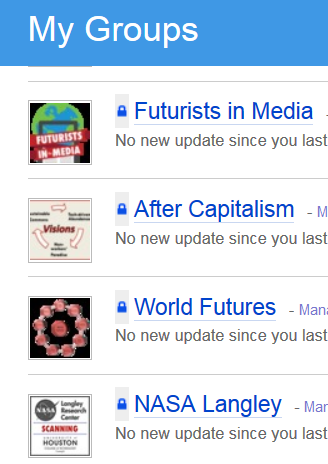One of the sessions at this weekend’s “Scanning the Fringe” event hosted by the Houston Foresight program with the Association of Professional Futurists is “tool time.” The purpose is to share tools we use to help us identify scanning hits on the fringe. Reflecting on my use of scanning tools in general, I thought I’d share one of my favorites, although it’s not a fringe detector, but a mechanism for collecting scan hits.
Older readers might remember the days of preparing spreadsheets with brief synopses of sc an hits. Sharing the spreadsheet was often problematic (who has the latest version…oh no, I was updating it, too). Much older readers might even remember clipping newspapers and magazines. Literally, with scissors, taping it onto a white 8.5×11 sheet and placing it in one of the several hundred topical folders in a massive file cabinet system.
an hits. Sharing the spreadsheet was often problematic (who has the latest version…oh no, I was updating it, too). Much older readers might even remember clipping newspapers and magazines. Literally, with scissors, taping it onto a white 8.5×11 sheet and placing it in one of the several hundred topical folders in a massive file cabinet system.
The emergence of the cloud has made it so much easier to share, increasingly vital in a context where so many teams are virtual. Document sharing, such as google drive and dropbox, and the like came along. Virtual project management software emerged, such as BaseCamp.
We started using Diigo three or four years ago to tag and collect or scan hits. I love it! I know there are others out there, so I’m not making a case that Diigo is better than xyz, but rather promoting the great advantage of using cloud-based collection tools for scanning. You can set up a private group, invite your teammates, and start a project scanning library. It takes a few minutes to set up your free account, add a tagging icon to your bookmark menu, and you’re ready to go. I set up a scanning library with every project now – I just checked and I have a dozen of them that are still active to some degree. I sometimes find myself adding to the scanning library of a project we’ve finished, well, because I can’t help it.
When you find a scan hit on the web, it only takes a minute or two to click the diigo icon, highlight a summary paragraph, maybe add a sentence or two on why you thought its important, add your tags, and save to your project group. We have adopted a tagging system that uses the project’s 1st two levels of the domain map as the first two tags. Then we add a tag or two specific to the piece. Increasingly, we also add a H1, H2, or H3 tag to indicate which time horizon the scan hit is aimed at. Tag discipline is important. When you have several hundred hits in a scanning library, it’s really nice to be able to quickly call up what you want.
I could go on and on – I already have! If you aren’t using one of these tools, try it! — Andy Hines
A very interesting post Andy. When I wrote a paper on intelligence scanning I often wondered what cloud based systems would emerge to assist scanning activities. I’ll be sure to give Diigo a try.